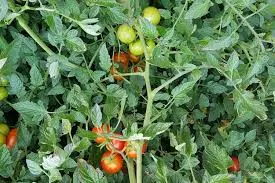"Here's a article titled "The Tomato: Cultivation, Health Benefits, and Medicinal Properties" that includes detailed descriptions and keyword integration for better search engine visibility".
The Tomato: Cultivation, Health Benefits, and Medicinal Properties.
Introduction to the Tomato
The tomato (Solanum lycopersicum) is a globally cultivated fruit, commonly used as a vegetable in culinary practices. Native to South America, tomatoes have become a dietary staple worldwide due to their rich flavor, versatility, and impressive nutritional profile. This article explores the tomato's cultivation process, health benefits, and medicinal properties, providing a complete guide for both home gardeners and health-conscious readers.
1. Tomato Cultivation: How to Grow Tomatoes Successfully
Growing tomatoes requires attention to soil, climate, water, and pest management. Follow these steps for optimal tomato growth:
1.1 Climate and Soil Requirements
Tomatoes thrive in warm climates with temperatures between 21°C and 27°C (70°F to 80°F). They require well-drained, fertile soil with a pH range of 6.0 to 6.8. Loamy soil enriched with organic matter is ideal for maximum yield.
-
Add compost or aged manure to enrich the soil.
-
Use raised beds or containers for better drainage if soil quality is poor.
1.2 Seed Selection and Germination Planting
Tomatoes can be started from seeds or seedlings.
-
Start seeds indoors 6–8 weeks before the last frost.
-
Transplant seedlings when outdoor temperatures are consistently above 50°F (10°C).
1.3 Transplanting and Spacing
1.4 Sunlight, Watering and Fertilization
- 6–8 hours of direct sunlight
Water deeply but infrequently to encourage deep root growth. Avoid overhead watering to prevent fungal diseases.
-
Apply a balanced fertilizer at planting.
-
Once flowering begins, switch to a low-nitrogen, high-phosphorus fertilizer to boost fruit production.
1.5 Pest and Disease Management
-
Use companion planting (e.g., basil, marigold) to deter pests.
-
Rotate crops yearly to prevent soil-borne diseases like blight.
-
Inspect plants regularly for aphids, whiteflies, and fungal issues.
1.6 Harvesting
Tomatoes are typically ready to harvest 60–85 days after transplanting. Pick when fully colored but still firm.
2. Health Benefits of Tomatoes
Tomatoes are a nutritional powerhouse. Rich in vitamins, antioxidants, and dietary fiber, they support various aspects of health.
2.1 Nutritional Profile
-
Vitamin C: Strengthens the immune system.
-
Vitamin K: Important for bone health.
-
Potassium: Helps regulate blood pressure.
-
Folate: Essential for cell repair and development.
-
Lycopene: A powerful antioxidant linked to many health benefits.
2.2 Health Benefits
Heart Health
Lycopene and potassium help reduce blood pressure, improve cholesterol levels, and lower the risk of heart disease.
Cancer Prevention
Antioxidants like lycopene are linked to a reduced risk of certain cancers, especially prostate, lung, and stomach cancers.
Skin Protection
Tomatoes can help protect against UV damage, slow down skin aging, and promote a healthy complexion.
Vision Health
Rich in vitamin A and lutein, tomatoes support eye health and may reduce the risk of macular degeneration.
Weight Management
Low in calories and high in fiber, tomatoes promote satiety and aid in weight loss efforts.
3. Medicinal Properties of Tomatoes
Beyond nutrition, tomatoes offer therapeutic properties that have been used in traditional and modern medicine.
3.1 Anti-inflammatory Effects
Tomatoes contain bioactive compounds that help reduce inflammation, which may benefit conditions like arthritis and metabolic syndrome.
3.2 Diabetes Management
The fiber and antioxidants in tomatoes can help regulate blood sugar levels and improve insulin sensitivity.
3.3 Detoxification
Tomatoes support liver function and help eliminate toxins due to their high water content and antioxidant profile.
3.4 Natural Diuretic
Tomatoes act as a natural diuretic, aiding in kidney function and reducing water retention.
3.5 Wound Healing and Skin Application
Tomato pulp can be used topically for minor burns, acne, and skin irritation due to its antiseptic and cooling properties.
3.6 Blood Sugar Regulation
Tomatoes have a low glycemic index and contain compounds that may help regulate blood sugar, supporting diabetic health.
3.7 Bone Health
Vitamin K, calcium, and lycopene work together to strengthen bones and reduce the risk of osteoporosis.
Conclusion
The tomato is more than just a kitchen staple. Its cultivation is accessible for home gardeners, and its health and medicinal benefits make it a true superfood. Whether you are looking to grow tomatoes in your backyard or boost your health through diet, understanding the nutritional and healing power of tomatoes is an excellent place to start.
Feel free to ask if you'd like more details on any specific aspect!
😊URL : https://vsendigitalmarketing.blogspot.com/
Sponsor Key-Word
"This Content Sponsored by Buymote Shopping app
BuyMote E-Shopping Application is One of the Online Shopping App
Now Available on Play Store & App Store (Buymote E-Shopping)
Click Below Link and Install Application: https://buymote.shop/links/0f5993744a9213079a6b53e8
Sponsor Content: #buymote #buymoteeshopping #buymoteonline #buymoteshopping #buymoteapplication"










No comments:
Post a Comment
Yes